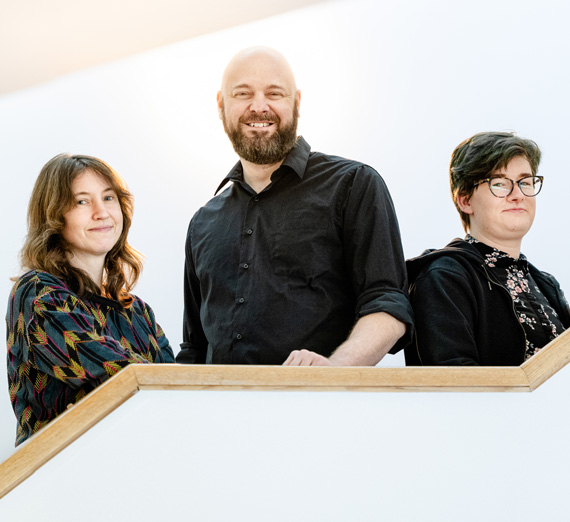Research Librarians Describe Many Ways to Use Artificial Intelligence

The growth of Gonzaga’s library from College Hall to Crosby Center to the Foley Center mirrors in some way the evolution of technology, from the first computer in 1966, the internet and now, Artificial Intelligence.
A constant has been the presence of the librarian. Foley library is home to a number of librarians, including specific liaisons for each department to provide assistance to faculty and students. Among them are Anthony Tardiff, instruction and first-year engagement librarian, Candise Branum, health sciences librarian, and Nicole Gustavsen, STEM specialist librarian.
Dissecting and helping others use AI has become a specialty of these three.
A variety of AI platforms are available for use, including ChatGPT, Microsoft’s Bing Chat, and Google’s Bard. When asked “how do research librarians use AI to help faculty and students?” in Bard’s platform, the AI summarized a list of ways in which research librarians, such as Tardiff, Branum and Gustavsen, use AI regarding research. Improving search results, recommending resources, providing personalized assistance and teaching and training were the four categories Bard outlined.
Improving search results
All three librarians agree that AI aids research by simplifying the research process and allowing more time for analysis, synthesis and discovery. For example, Gustavsen says that a chatbot such as ChatGPT “can help you craft good search strings that you can use in a database,” which Tardiff mentions helps to “simplify the search process and make it generally accessible by allowing users to find useful results through natural language searching.”Essentially, AI can help users by developing search terms that are more likely to get the results they want, and it can help search engines better understand the type of answer a user is looking for.
Recommending resources
AI is already embedded in many of the tools we use, such as auto-suggestion when typing or browsing the web and unlocking technology with facial recognition. Features such as auto-suggestion help users by providing them with options of what they might look up next or correcting an error with suggestions of what they most likely meant to write.
Branum, Gustavsen and Tardiff point to other AI tools that can help faculty and students find resources. Tardiff describes the Consensus app as “the first AI tool that I have found genuinely useful for research. Tools like this, in which the AI is not generating information but is instead surfacing it via the discovery of human-written academic articles, have the potential to be very valuable when they mature.” The Consensus app is relatively new and prone to errors, particularly as it is pulling from a small number of resources to deliver results.
Providing personalized assistance
One of AI’s best features is that it can help prepare students for further research. Branum says that AI can be helpful in brainstorming ideas, creating outlines and highlighting areas that can be further investigated. Tardiff adds that AI can suggest new lines of thought and can even help to strengthen one’s argument by providing opposing viewpoints. This can be helpful for students developing research topics and arguments.ChatGPT can be supportive in offering basic definitions, providing synonyms and helping to build a platform from which to conduct research. Gustavsen says that a chatbot can be useful while reading a literature review or academic article, providing unknown terms or mentioned studies and figures. Chatbots like ChatGPT also save the conversation, which allows users to go back and see the steps that led them to their results.
Teaching and training
Branum says AI is already frequently used in the medical field in education and practice, such as through virtual simulations and communication skills development. AI is used to look at health records to find trends, make predictions and identify outbreaks.AI is used in other fields as well, such as tracking climate patterns, developing quantum computing frameworks, coding and doing advanced math.
Outside the workplace and academics, AI can be used for basic learning and quick topic searches. Gustavsen likes the conversational aspect of AI chatbots and how they help us to learn better than reading a Wikipedia article or digging through websites.
I’m a text-based AI, and that is outside of my capabilities.
While Gonzaga’s librarians point out the helpfulness of AI, they also caution against many of its shortcomings.
Branum points out that right now, AI is talked about in a flashy way in the media, but Chat GPT is simply a text generator, and no AI can take the place of a human conducting research in a traditional research database at this time.
ChatGPT is bad at retrieving academic articles and "cannot replicate the skills and discernment required in building a search strategy, conducting a search database and selecting evidence that fits with your research topic,” Branum states.
Gustavsen warns against using ChatGPT for citations, bibliographies, further reading suggestions or PDF summaries due to its lack of knowledge of recent events, information on topics outside of Western mainstream media and other rampant inaccuracies.
All three librarians point out that AI has no knowledge of its own and is not a conscious entity. AI is difficult (if not impossible) to be free of bias. While people want to believe technology is bias-free, Branum notes that humans, who are inherently biased, build, train and use AI, which results in biased technology.
“It will always be the researcher’s responsibility to determine biases... and to recognize how their own biases shape a response to what they are reading, viewing and hearing,” Gustavsen says.
“AI is advancing at a rapid pace, and I think we’ll find inventive ways to use it to our advantage, but database research still requires a human hand,” Branum says.
For now, AI is a helpful tool that when used correctly, can aid students and faculty in streamlining their research process, help to uncover new resources and teach others about concepts across a variety of academic disciplines.
